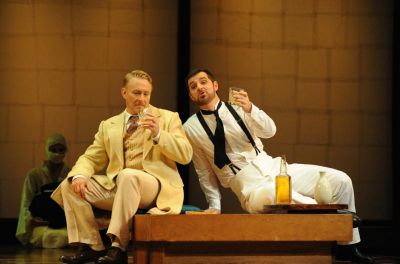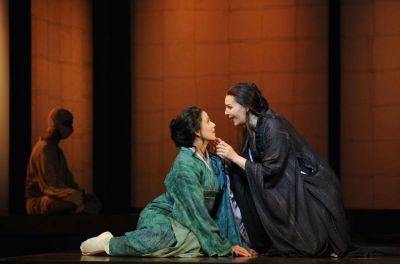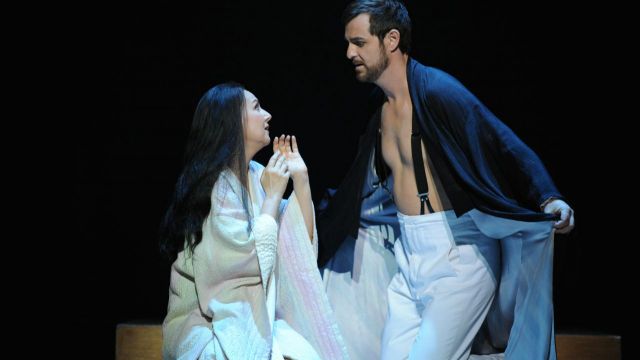Madama Butterfly
The 1997 set and costume design for this production is just as stunning as it must have been for its original audience. The decision by director Moffatt Oxenbould and graduating NIDA designers Peter England and Russell Cohen to call upon the traditions of Kabuki, Noh and Bunraku theatre sets the production firmly in Japan. And, it accentuates the exotic view that Westerners had of the orient at the turn of last century. It also enhances the authenticity of the ceremonies and rituals that Puccini ensured were worked into the libretto.
A stage of wooden platforms is surrounded by a moat of shimmering water and flickering candles and enclosed with sliding rice paper screens. Sparkling star curtains and a shining moon add to the romance and underline how westerners visiting Japan were captured by its beauty and allure.
The costumes too evoke the flowing lines and vibrant colours of traditional Japan. As well, they accentuate the stark contrast to the tightly-laced, restrictive European fashions of 1904 when Madama Butterfly was first performed. Simply dressed and masked, non-performing assistants, known as Koken in the Kabuki tradition, add even more to authenticity and simplicity of this staging of Butterfly.
The opera is based on a one-act play by David Belasco seen when Puccini visited London in 1900 for the first English production of Tosca. But it is not just a tragic love story of a Japanese wife waiting patiently and faithfully with her little son for the return of her American husband, Captain Pinkerton. Itis also an allegory on 19th century Imperialism and its exploitation of ‘new’ lands and their people.

Into this setting comes Puccini’s music. It too was influenced by the music of Japan. There are Japanese bells and tam-tams and the use of pentatonic scale help to set the opera subtly in Japan and evoke the changes in mood and atmosphere. Romance and joy pervade the opening scenes: in Butterfly’s opening aria; in her maid Suzuki’s prayers; in Butterfly’s duet with Pinkerton; and in the sad optimism of the famous aria ‘Un be di’ (One Fine Day).
The orchestra, under the baton of Gianluca Martinenghi, finds the essence of all of the emotions that Puccini worked into the score, especially the sadness as Butterfly waits and waits silently on the stage after she sees Pinkerton’s ship return to the harbour.
Alexia Voulgaridou is heart-breakingly moving as Butterfly, her voice finding every nuance and of Butterfly’s joy, unwavering faith and eventual despair. She is naïve and trusting compared with James Egglestone’s strutting deception. But their love duet is beautifully sung and performed, despite the inference of evil that lingers when she asks him if it is true that in America butterflies are pinned to a board to be displayed and he answers that this is done so they will not fly away.

As Suzuki, Sian Pendry is vocally rich and very authentically Japanese in her movements and reactions. Graeme McFarlane has moved from a sniffing Sacristan in Tosca to a very pompous and persuasive marriage broker in this production. His costume is a lovely mixture of East and West and makes a telling comment on the influences of imperialism.
Michael Honeyman plays the United States Consul, Sharpless, and brings stature and compassion to the role. Jud Arthur and Samuel Dundas as The Bonze and Prince Yamadori are pictures of oriental male splendour in their stunning costumes.
The voices and exotic costumes of the supporting cast and the appealing naturalness of the little boy who plays Butterfly’s son all add to the magic of this much-loved opera and the tragic story of its sad heroine.
Carol Wimmer
Images: Alexia Voulgaridou (Ciocio San) & James Egglestone (Pinkerton); Michael Honeyman (Sharpless) & James Egglestone (Pinkerton) and Sian Pendry (Suzuki) & Alexia Voulgaridou (Ciocio San) in Opera Australia's Madama Butterfly. Photographer: Branco Gaica.
Subscribe to our E-Newsletter, buy our latest print edition or find a Performing Arts book at Book Nook.

